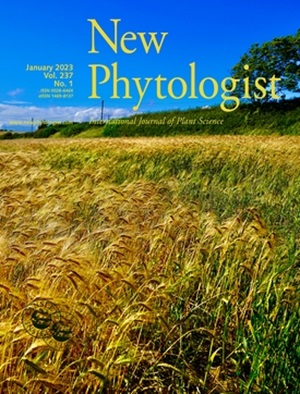Transgene-free genome editing in poplar
IF 8.3
1区 生物学
Q1 PLANT SCIENCES
引用次数: 0
Abstract
- Precise gene-editing methods are valuable tools to enhance genetic traits. Gene editing is commonly achieved via stable integration of a gene-editing cassette in the plant's genome. However, this technique is unfavorable for field applications, especially in vegetatively propagated plants, such as many commercial tree species, where the gene-editing cassette cannot be segregated away without breaking the genetic constitution of the elite variety.
- Here, we describe an efficient method for generating gene-edited Populus tremula × P. alba (poplar) trees without incorporating foreign DNA into its genome. Using Agrobacterium tumefaciens, we expressed a base-editing construct targeting CCoAOMT1 along with the ALS genes for positive selection on a chlorsulfuron-containing medium.
- About 50% of the regenerated shoots were derived from transient transformation and were free of T-DNA. Overall, 7% of the chlorsulfuron-resistant shoots were T-DNA free, edited in the CCoAOMT1 gene and nonchimeric.
- Long-read whole-genome sequencing confirmed the absence of any foreign DNA in the tested gene-edited lines. Additionally, we evaluated the CodA gene as a negative selection marker to eliminate lines that stably incorporated the T-DNA into their genome. Although the latter negative selection is not essential for selecting transgene-free, gene-edited Populus tremula × P. alba shoots, it may prove valuable for other genotypes or varieties.
杨树无转基因基因组编辑
精确的基因编辑方法是增强遗传性状的宝贵工具。基因编辑通常是通过在植物基因组中稳定整合基因编辑盒来实现的。然而,这种技术不利于田间应用,特别是在无性繁殖的植物中,例如许多商业树种,在这些植物中,基因编辑盒不能在不破坏优良品种遗传结构的情况下分离出来。在这里,我们描述了一种有效的方法来产生基因编辑的杨树,而不将外源DNA纳入其基因组。利用农杆菌,我们表达了一个针对CCoAOMT1和ALS基因的碱基编辑构建体,并在含氯磺隆的培养基上进行了阳性选择。约50%的再生芽来自瞬时转化,不含T-DNA。总体而言,7%的抗氯磺隆芽是无T-DNA的,在CCoAOMT1基因中进行了编辑,并且是非嵌合的。长读全基因组测序证实,在测试的基因编辑品系中没有任何外源DNA。此外,我们评估了CodA基因作为负选择标记,以淘汰稳定地将T-DNA整合到其基因组中的品系。虽然后一种负选择对于选择无转基因、基因编辑的白杨芽不是必需的,但它可能对其他基因型或品种有价值。
本文章由计算机程序翻译,如有差异,请以英文原文为准。
求助全文
约1分钟内获得全文
求助全文
来源期刊

New Phytologist
生物-植物科学
自引率
5.30%
发文量
728
期刊介绍:
New Phytologist is an international electronic journal published 24 times a year. It is owned by the New Phytologist Foundation, a non-profit-making charitable organization dedicated to promoting plant science. The journal publishes excellent, novel, rigorous, and timely research and scholarship in plant science and its applications. The articles cover topics in five sections: Physiology & Development, Environment, Interaction, Evolution, and Transformative Plant Biotechnology. These sections encompass intracellular processes, global environmental change, and encourage cross-disciplinary approaches. The journal recognizes the use of techniques from molecular and cell biology, functional genomics, modeling, and system-based approaches in plant science. Abstracting and Indexing Information for New Phytologist includes Academic Search, AgBiotech News & Information, Agroforestry Abstracts, Biochemistry & Biophysics Citation Index, Botanical Pesticides, CAB Abstracts®, Environment Index, Global Health, and Plant Breeding Abstracts, and others.
 求助内容:
求助内容: 应助结果提醒方式:
应助结果提醒方式:


